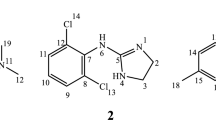Abstract
Purpose. A method for obtaining clear supersaturated aqueous solutions for parenteral administration of the poorly soluble experimental anti-cancer drug silatecan 7-t-butyldimethylsilyl-10-hydroxycamptothecin (DB-67) has been developed.
Methods. Equilibrium solubilities of DB-67 were determined in various solvents and pH values, and in the presence of chemically modified water-soluble β-cyclodextrins. The stoichiometry and binding constants for complexes of the lactone form of DB-67 and its ring-opened carboxylate with sulfobutyl ether and 2-hydroxypropyl substituted β-cyclodextrins (SBE-CD and HP-CD) were obtained by solubility and circular dichroism spectroscopy, respectively. Kinetics for the reversible ring-opening of DB-67 in aqueous solution and for lactone precipitation were determined by HPLC with UV detection.
Results. Solubilities of DB-67 lactone in various injectable solvent systems were found to be at least one order of magnitude below the target concentration (2 mg/ml). DB-67 forms inclusion complexes with SBE-CD and HP-CD but the solubilization attainable is substantially less than the target concentration. Slow addition of DB-67/DMSO into 22.2% (w/v) SBE-CD failed to yield stable supersaturated solutions due to precipitation. Stable supersatured solutions were obtained, however, by mixing a concentrated alkaline aqueous solution of DB-67 carboxylate with an acidified 22.2% (w/v) SBE-CD solution. Ring-closure yielded supersaturated solutions that could be lyophilized and reconstituted to clear, stable, supersaturated solutions.
Conclusions. The method developed provides an alternative to colloidal dispersions (e.g., liposomal suspensions, emulsions, etc.) for parenteral administration of lipophilic camptothecin analogs.
Similar content being viewed by others
REFERENCES
S. Sweetana and M. J. Akers. Solubility principles and practices for parenteral drug dosage form development. PDA J. Pharm. Sci. Technol. 50:330–342 (1996).
D. J. W. Grant and T. Higuchi. Solubility Behavior of Organic Compounds, John Wiley & Sons, Inc., New York, 1990.
J. J. Torres-Labandeira, P. Davignon, and J. Pitha. Oversaturated solutions of drug in hydroxypropylcyclodextrins: Parenteral preparation of pancratistatin. J. Pharm. Sci. 80:384–386 (1990).
D. Bom, D. P. Curran, S. Kruszewski, S. G. Zimmer, S. J. Thompson, G. Kohlhagen, W. Du, A. J. Chavan, K. A. Fraley, A. L. Bingcang, J. J. Latus, Y. Pommier, and T. G. Burke. The novel silatecan 7-tert-butyldimethylsilyl-10-hydroxycamptothecin displays high lipophilicity, improved human blood stability, and potent anticancer activity. J. Med. Chem. 43:3970–3980 (2000).
C. Jaxel, K. W. Kohn, M. C. Wani, M. E. Wall, and Y. Pommier. Structure-activity study of the actions of camptothecin derivatives on mammalian topoisomerase I: Evidence for a specific receptor site and a relation to antitumor activity. Cancer Res. 49: 1465–1469 (1989).
Y. H. Hsiang, M. G. Lihou, and L. F. Liu. Arrest of replication forks by drug-stabilized topoispomerase I-DNA cleavable complexes as a mechanism of cell killing by camptothecin. Cancer Res. 49:5077–5082 (1989).
Y. H. Hsiang, L. F. Liu, M. E. Wall, M. C. Wani, A. W. Nicholas, G. Manikumar, S. Kirschenbaum, R. Silber, and M. Potmesil. DNA topoisomerase I-mediated DNA cleavage and cytotoxicity of camptothecin analogues. Cancer Res. 49:4385–4389 (1989).
R. P. Hertzberg, M. J. Caranfa, K. G. Holden, D. R. Jakas, G. Gallagher, M. R. Mattern, S. M. Mong, J. O. Bartus, R. K. Johnson, and W. D. Kingsbury. Modification of the hydroxy lactone ring of camptothecin: Inhibition of mammalian topoisomerase I and biologic activity. J. Med. Chem. 32:715–720 (1989).
R. Kapoor, D. L. Slade, A. Fujimori, Y. Pommier, and W. G. Harker. Altered topoisomerase I expression in two subclones of human CEM leukemia selected for resistance to camptothecin. Oncol. Res. 7:83–95 (1995).
L. S. Rosen. Irinotecan in lymphoma, leukemia, and breast, pancreatic, ovarian, and small-cell lung cancers. Oncology (Huntingt). 12:103–109 (1998).
C. Kollmannsberger, K. Mross, A. Jakob, L. Kanz, and C. Bokemeyer. Topotecan-A novel topoisomerase I inhibitor: pharmacology and clinical experience. Oncology. 56:1–12 (1999).
D. J. Adams, M. W. Dewhirst, J. L. Flowers, M. P. Gamcsik, O. M. Colvin, G. Manikumar, M. C. Wani, and M. E. Wall. Camptothecin analogues with enhanced antitumor activity at acidic pH. Cancer Chemother. Pharmacol. 46:263–271 (2000).
A. Inoue and N. Saijo. Recent advances in the chemotherapy of non-small cell lung cancer. Jpn. J. Clin. Oncol. 31:299–304 (2001).
J. Fassberg and V. J. Stella. A kinetic and mechanistic study of the hydrolysis of camptothecin and some analogues. J. Pharm. Sci. 81:676–684 (1992).
J. G. Supko and L. Malspeis. Pharmacokinetics of the 9-amino and 10,11-methylenedioxy derivatives of camptothecin in mice. Cancer Res. 53:3062–3069 (1993).
N. B. Haas, F. P. LaCreta, J. Walczak, G. R. Hudes, J. M. Brennan, R. F. Ozols, and P. J. O'Dwyer. Phase I/pharmacokinetic study of topotecan by 24-hour continuous infusion weekly. Cancer Res. 54:1220–1226 (1994).
H. A. Benesi and J. H. Hildebrand. A spectrophotometric investigation of the interaction of iodine with aromatic hydrocarbons. J. Am. Chem. Soc. 71:2703–2707 (1949).
Rights and permissions
About this article
Cite this article
Xiang, Tx., Anderson, B.D. Stable Supersaturated Aqueous Solutions of Silatecan 7-t-Butyldimethylsilyl-10-Hydroxycamptothecin via Chemical Conversion in the Presence of a Chemically Modified β-Cyclodextrin. Pharm Res 19, 1215–1222 (2002). https://doi.org/10.1023/A:1019862629357
Issue Date:
DOI: https://doi.org/10.1023/A:1019862629357




